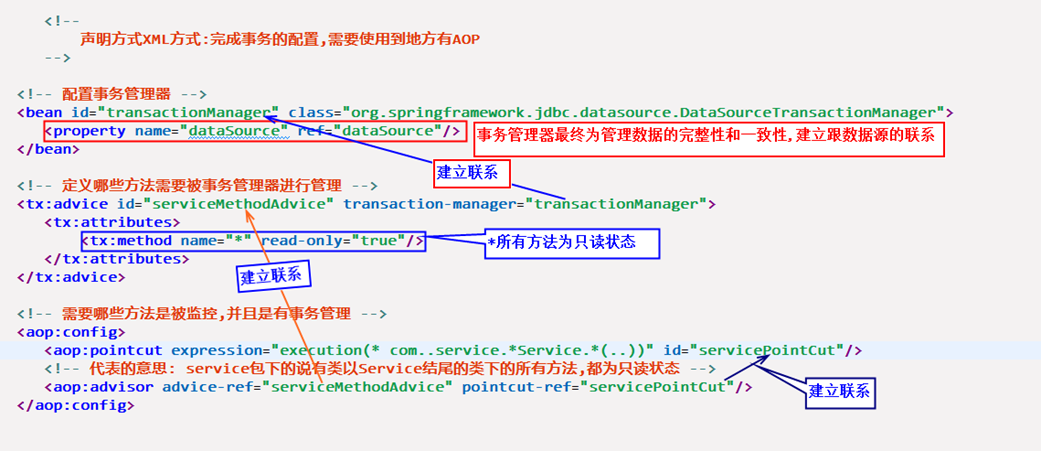事务管理: 管理事务,管理数据,数据完整性和一致性
事务[业务逻辑] : 由一系列的动作[查询书价格,更新库存,更新余额],组成一个单元[买书业务],
当我们动作当中有一个错了,全错~
ACID
原子性 隔离性 一致性 持久性
注解方式配置事务[编程方式-->@代码]
1.Spring框架当中需要配置事务管理器--> JDBC[Mybatis] Hibernate JTA-->数据源
2.启动事务注解[特意说了,事务管理器的id]
3.事务注解--> 可以放置的位置:@Transaction 类或者方法上
- 类上放置注解 方法当中注解[reaonly=true]
- rollbakFor
- 传播性 7个 默认值
XML方式配置事务
|
<!-- 声明方式XML方式:完成事务的配置,需要使用到地方有AOP --> <!-- 配置事务管理器 --> <bean id="transactionManager" class="org.springframework.jdbc.datasource.DataSourceTransactionManager"> <property name="dataSource" ref="dataSource"/> </bean> <!-- 定义哪些方法需要被事务管理器进行管理 --> <tx:advice id="serviceMethodAdvice" transaction-manager="transactionManager"> <tx:attributes> <tx:method name="*" read-only="true"/> </tx:attributes> </tx:advice> <!-- 需要哪些方法是被监控,并且是有事务管理 --> <aop:config> <aop:pointcut expression="execution(* com..service.*Service.*(..))" id="servicePointCut"/> <!-- 代表的意思: service包下的说有类以Service结尾的类下的所有方法,都为只读状态 --> <aop:advisor advice-ref="serviceMethodAdvice" pointcut-ref="servicePointCut"/> </aop:config> |

单元测试,推荐使用断言方式,需要再使用syso的输出方式
|
<!-- 定义哪些方法需要被事务管理器进行管理 --> <tx:advice id="serviceMethodAdvice" transaction-manager="transactionManager"> <tx:attributes> <!-- 约定大于配置 --> <!-- 第一种配置方式 <tx:method name="*" read-only="true"/> <tx:method name="add*" propagation="REQUIRED"/> <tx:method name="insert*"/> <tx:method name="create*"/> <tx:method name="update*"/> <tx:method name="edit*"/> <tx:method name="mod*"/> <tx:method name="change*"/> <tx:method name="del*"/> <tx:method name="remove*"/> <tx:method name="cancel*"/> --> <!-- 第二种配置方式 --> <tx:method name="*" read-only="false" /> <tx:method name="get*" read-only="true"/> <tx:method name="load*" read-only="true"/> <tx:method name="list*" read-only="true"/> <tx:method name="find*" read-only="true"/> <tx:method name="sel*" read-only="true"/> <tx:method name="query*" read-only="true"/> </tx:attributes> </tx:advice> |
在这里胖哥想说的,帮助文档一定要看,有一些事情我强调了很多很多遍,你们不走心,我也无能为力!
|
Again in keeping with Spring's philosophy, the TransactionException that can be thrown by any of the PlatformTransactionManager interface's methods is unchecked (that is, it extends the java.lang.RuntimeException class). Transaction infrastructure failures are almost invariably fatal. In rare cases where application code can actually recover from a transaction failure, the application developer can still choose to catch and handle TransactionException. The salient point is that developers are not forced to do so. The getTransaction(..) method returns a TransactionStatus object, depending on a TransactionDefinition parameter. The returned TransactionStatus might represent a new transaction, or can represent an existing transaction if a matching transaction exists in the current call stack. The implication in this latter case is that, as with Java EE transaction contexts, a TransactionStatus is associated with a thread of execution. The TransactionDefinition interface specifies:
|
|
重点: 绝对是个人的建议 RuntimeException默认是不受审查,也是rollBackFor的默认值,如果你再Service层或者Dao层对其进行捕获的话,那么一定要做处理 个人的建议为: service和Dao不管遇到什么请求你都处理往外抛, 处理都放置在Controller 关于异常尽量都是用继承RuntimeException,根据你的代码情况进行不同异常的封装
|
今天的笔记做的不好! 累了!~~~ 付出的越多!~~~ 有的时候失望越多!~~~ 该何去何从!~~~~